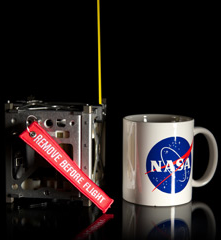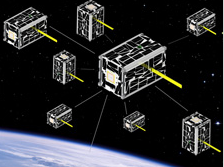If there's anyone who knows about spacecraft technology, it's the Chief of Mission Design Division (MDD) at NASA's Ames Research Center, Chad Frost. Being at the forefront of the aerospace industry for more than 25 years, Frost has designed and analyzed many flight control systems for aircraft. Now leading the MDD, he and his staff develop new spacecraft, technologies, tools, and mission concepts to accomplish revolutionary science on strict budgets.
Each year, millions of dollars go into spacecraft hardware, avionics, electronics, and software, even for small satellites. But as the world's technology constantly advances, new and unexpected ideas are born.
“A few years ago, we had the intriguing idea that you might actually be able to build a spacecraft around a smartphone,” Frost said. “As a society, we've driven consumer electronics really hard to the point where they are just amazingly capable little devices, and ridiculously affordable for what they can do.”
With that in mind, NASA began brainstorming ways to build systems around familiar everyday technology. Intrigued by building a much smaller spacecraft based entirely on consumer devices and other low-cost systems, NASA got to work on combining a consumer-grade smartphone in conjunction with other commercial off-the-shelf components. The result was the PhoneSat project, the joint effort of three smartphones in orbit, as part of NASA's nanosatellite mission.

Image taken by the PhoneSat 2.0 (Graham) nanosatellite. Reconstructed by the Ames PhoneSat Team. Credit: NASA Ames
The ultimate goal of the PhoneSat mission was to determine whether consumer-grade smartphones could be used as main flight avionics for satellites in space. NASA's PhoneSat satellites, each about the size of a coffee cup, were already equipped with many of the systems needed for a satellite, including GPS receivers, fast processors, versatile operating systems, multiple miniature sensors, and several radios. They rode to space aboard the maiden flight of Orbital Science Corp.'s Antares rocket from NASA's Wallops Island Flight Facility in Virginia. After the launch, the satellites functioned in space for short periods of time, sending back small digital images of Earth and space from their smartphone cameras before burning up in Earth's atmosphere, as predicted. Engineers at NASA's Ames Research Center pieced together the multiple tiny pictures in order to form the complete view of Earth. Overall, the mission was a success.
“From our standpoint, PhoneSat is probably the first of a whole new generation of really intriguing new spacecraft capabilities,” Frost said.

A PhoneSat satellite is the size of a coffee cup. Credit: NASA Ames
Another mission, set to launch in a few months, the Edison Demonstration of SmallSat Networks (EDSN), will simultaneously send off eight cubesats into orbit, 500 km above Earth. The EDSN project is developing technology to send affordable advanced nanosatellites into space with cross-link communications to enable scientific, commercial, and academic research. A main goal of the EDSN mission is to figure out how to lower the cost and shorten development time for future small spacecraft.
“They'll do a little bit of science, a little bit of technology, proving out some concepts and systems,” said Frost of the EDSN mission's small spacecraft. “But after that, there's a lot of possibilities.”

Representation of the eight EDSN spacecraft in orbit. Image via nasa.gov.
According to Frost, the downsizing of technology may create many new affordable ideas for the future, such as weather monitoring systems, providing early warning signals in case of severe weather conditions. There may be Earth observation systems with high resolution and detailed hyperspectral imagery, able to snap pictures of Earthly phenomena, but instead of using something the size of a Hubble Space Telescope, images can be captured with multiple, smaller, individual cameras.
With swarms of small spacecraft hovering above Earth, Frost believes the notion of apps in space is becoming a very real possibility. “I see the revolution in electronics as being the thing that has most, fundamentally, transformed what we can do and what we will be able to do in the future,” he said. “It's wildly exciting.”
Littelfuse has created a NASA Exploration & Discovery Experience for the engineering community as part of its 2013 Speed2Design program. Winning design engineers will get the opportunity to go behind the scenes to spend time with NASA engineers at two NASA facilities. For more information and to enter, visit speed2design.com.
By Nicole DiGiose
Advertisement
Learn more about Electronic Products MagazineLittelfuse





